Faberge Imperial Easter Eggs
www.Gatchino.com/Jeweller/Faberge/

FabergeImperialEasterEggs
Императорские пасхальные яйца Фаберже
О Музее искусств Уолтерса
About The Walters Art Museum
The Museum
The Walters Art Museum is internationally renowned for its collection, which was amassed substantially by two men, William and Henry Walters. The collection presents an overview of world art from pre-dynastic Egypt to 20th-century Europe, and counts among its many treasures Greek sculpture and Roman sarcophagi; medieval ivories and Old Master paintings; Art Deco jewelry and 19th-century masterpieces. In fall 2001, the Walters celebrated the Grand Reopening of its largest building, which underwent a dramatic three-year renovation. The renovation allows many objects to be on view for the first time, and presents the collection in a dramatic new light.
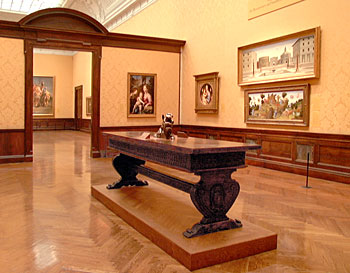
The Walters Art Museum
Experience 55 Centuries of Art ©
Mission
Preamble
The Walters Art Museum preserves and develops in the public trust a distinguished collection of world art from antiquity to the 20th century. In 1931, the museum's founding benefactor, Henry Walters, bequeathed the core collection to the City of Baltimore "for the benefit of the public." Since its opening, the Walters has been a national leader in scholarship, conservation, and education.
Mission Statement
The Walters Art Museum brings art and people together for enjoyment, discovery, and learning. We strive to create a place where people of every background can be touched by art. We are committed to exhibitions and programs that will strengthen and sustain our community.
History
During the 19th and early 20th centuries, William Thompson Walters and his son, Henry, assembled a diverse range of artworks from around the world—from European master paintings and decorative arts to Greek and Roman antiquities and Far Eastern ceramics. Together, they collected nearly 22,000 works of art, building the foundation for a museum that offers an extraordinary survey of 55 centuries.

William Walters (1819-94)
William Thompson Walters (1819-94), a native of the village of Liverpool in central Pennsylvania, was drawn to Baltimore in 1841. Initially Walters became a grain merchant, but by 1852 he had established a wholesale liquor house that was to become one of the largest firms of its kind anywhere. Six years later, Walters moved to a house on Mount Vernon Place, then the most fashionable residential district in Baltimore.
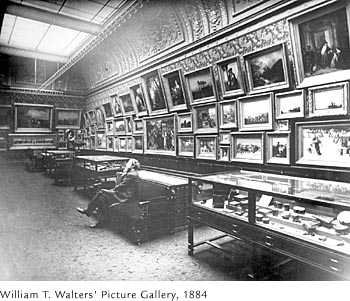
At about this time, Walters seriously began to collect art, initially patronizing local talents, among them Alfred Jacob Miller (1810-74), who had documented the early fur trade in the West, and the sculptor William H. Rinehart (1825-74).
Unlike most other collectors of the period, William Walters tentatively began to explore contemporary European painting, acquiring The Duel after the Masquerade, by Jean-Leon Gerome, an emerging academic master in Paris.
Prior to the Civil War, Walters had outspokenly defended the right of states to secede from the Union. When the conflict erupted in 1861, he found himself in an untenable position and left the country for Paris with his wife, Ellen, and two children, Henry and Jennie.
With George A. Lucas (1824-1909), a Baltimorean who four years earlier had moved to France, as their guide, William and Ellen Walters toured the major museums and monuments and visited artists' studios, sometimes accompanied by their children. Although his income was limited, Walters patronized contemporary French artists much as he had in Baltimore and New York, commissioning works from Gerome, Honore Daumier, and Antoine-Louis Barye, among others. When William Walters returned to Baltimore at the close of hostilities, his business interests now shifted from liquor to banking and railroads. He continued to expand his art collection, focusing on two fields, contemporary European painting and Asian art. Buying at auctions in New York, and relying on Lucas in Paris to transact purchases abroad, he specialized in French landscape and historical genre paintings. Walters' interests included Japanese lacquers, metalwork, and ceramics; among his Chinese acquisitions were examples of celadons and monochrome porcelains. Henry Walters, by then in his late twenties, had become his father's partner on shopping forays, and in 1889, when William was unable to travel to Paris, he attended exhibitions in his father's place.
As early as 1874 William Walters opened the Mount Vernon Place residence to the public. Every spring, with few exceptions, he continued this civic-minded practice, charging a fee of 50 cents, with the proceeds contributed to charity. Within a decade, when the collection had outgrown the house, he acquired an adjacent property and added a picture gallery.
When William Walters died in 1894, he bequeathed his collection to his son, Henry, who would follow in his father's footsteps.
Henry Walters (1848-1931)
In 1889 Henry Walters moved to Wilmington, North Carolina, to serve as general manager of his father's railroad. Following William's death in 1894, he was elected president of the Atlantic Coast Line Company and transferred the line's headquarters to New York. Henry had an uncanny flair for business, and under his leadership the railroad experienced rapid growth until World War I, acquiring the vast Plant system in Florida in 1902 and taking control of the Louisville and Nashville Railroad in the same year.
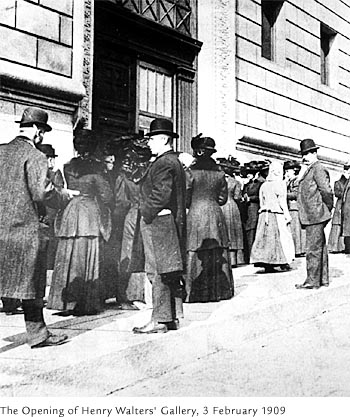
In New York Henry Walters lived with Pembroke and Sarah Jones, a couple he had met in Wilmington. Seldom did Walters return to Baltimore other than to attend board meetings of the Safe Deposit and Trust Company. Three years after Pembroke Jones' death in 1919, Henry married Sarah and they continued living in the Manhattan house surrounded by fine French 18th-century paintings and decorative arts and earlier Italian works of art. In his New York library Henry Walters kept many of his most prized rare books and manuscripts and other treasures.
From the outset, Henry Walters envisaged a museum that would fulfill an educational role within the community. Initially he made modest additions to his father's collection. Benefiting from historical perspective, he enhanced the breadth of the 19th-century holdings with such early works as Ingres' Betrothal of Raphael, bought in 1903. Although he did not find French Impressionism to his liking, he agreed in that year to buy two examples from Mary Cassatt-a small Degas portrait and Monet's Springtime, an exquisite image of the artist's wife, Camille, seated on the grass beneath lilac bushes in their garden at Argenteuil.
That Henry's ambitions for the collection far exceeded his father's became apparent in 1900 when he bought Raphael's Madonna of the Candelabra, which had passed through both the Borghese and Bonaparte family collections. Also that year he purchased a number of properties on Charles Street, in Mount Vernon Place, to serve as a site for a future gallery.
Two years later Henry undertook an acquisition on a scale unprecedented in the history of American collecting: he bought the contents of the Palazzo Accoramboni in Rome. The collection abounded in works of significance, many of them by masters other than those to whom they had been ascribed, and others by artists not in fashion at that time. In the latter category fell El Greco's painting St. Francis Receiving the Stigmata. Among the collection's archeological treasures were seven magnificent sarcophagi from a burial chamber associated with the Calpurnii Pisones family, pieces that alone would have justified the purchase of the collection. Henry courageously agreed to buy the collection for the sum of five million FF or $1,000,000. Once secured, Walters arranged for transport of the collection via a chartered steamer, the Minterne, to sail from Civitavecchia, Italy, to New York. There the collection was stored until the construction of Walters' new gallery building on the corner of Charles and Centre Streets was completed.
Henry Walters continued to augment his holdings, buying both in New York and abroad. Walters continued to collect Egyptian, ancient Near Eastern, and Islamic art, as well as a number of key classical and western medieval objects. Among the latter, the most spectacular was a pair of limestone heads of Old Testament rulers that had come from the abbey church of Saint-Denis. In 1897 the purchase of a 15th-century Koran, originally thought to be Persian, but now regarded as Indian, may have initiated the manuscript collection.
In New York, beginning in 1903, Henry Walters served on the executive committee of the Metropolitan Museum of Art, and 10 years later he became second vice president, a position he retained for the rest of his life. His experiences on a number of museum committees may have resulted in a change of direction in his collecting after World War I. Walters now appeared less concerned with acquiring works representative of various fields and more committed to objects of major historical and artistic significance. One of his most outstanding purchases was a panel showing a contemplative Donor with St. John the Baptist, painted in minute detail by the Flemish artist Hugo van der Goes. It was acquired from Jacques Seligmann in 1920.
From Gallery to Museum
Following Henry Walters' death in 1931, the mayor of Baltimore appointed a board of trustees who, in turn, consulted with a distinguished committee of museum personnel and scholars regarding the proper management of a public museum. Within a year, a research staff of five curators, a conservator, and a chemist had been appointed. The gallery very briefly reopened in the spring of 1934 to allow visitors to view for the last time the outdated, cluttered installations of the Henry Walters era. It was then closed to provide the staff with an opportunity to transform the gallery completely into a modern, public institution.
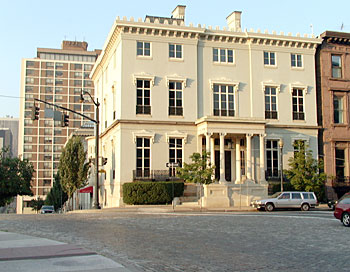
Over the summer, the curators catalogued the collections, prepared a handbook, and began to organize a number of pioneering exhibitions. Inevitably their efforts were constrained by the lack of adequate space to display the collections. Nevertheless, the gallery continued to augment its holdings through purchases and gifts, albeit at a modest pace. When Sarah Walters auctioned many of the works from her New York residence in 1941, the Walters trustees voted to bid for 11 of them, including a large, late antique vase carved out of a single piece of agate which had been taken as plunder from Constantinople by French crusaders in 1204. Subsequently it had passed through a number of distinguished collections, most notably that of the artist and diplomat Peter-Paul Rubens (1517-1640).
The first large donation to the Gallery came in 1963 when a collection of more than 400 European and American portrait miniatures assembled by a local business leader, Abraham Jay Fink (1890-1963), was presented to the Gallery. Most of the miniatures dated from the 18th and 19th centuries, although there were also a number of earlier examples, including a pair of portraits painted by the Utrecht artist Cornelius van Poelenburch.
The Gallery's initial purchase policy was to enhance those aspects of the collection that were inadequately represented rather than to emphasize existing strengths. To augment its Flemish holdings, for example, the Gallery purchased in 1948 a 17th-century view of the Infanta Isabella of Spain and her husband, the Archduke Albert, visiting a collector's cabinet of natural curiosities and artistic treasures. The authorship of this work, which once belonged to Walters' rival collector and business associate, J. Pierpont Morgan (1837-1913), has been debated, but is now identified as Frans Francken II and workshop, with Jan Brueghel II.
In 1972 the Gallery fortuitously reunited a pair of Canaanite bronze figurines from the early second millennium BC which had been separated in 1919. Likewise, ten years later, the Gallery acquired a 16th-century Venetian gold marten's head, nearly identical to one appearing mounted on a pelt in Paolo Veronese's Portrait of Countess Livia da Porto Thiene and her Daughter, Portia.
1974 Expansion
Attempts to win financial support for a major building expansion failed in 1958 and the 1960s. Only in 1966 did Baltimore City's passage of a bond issue, together with a grant from the State of Maryland and private contributions, enable the museum to realize plans for more exhibition space. Shepley, Bulfinch, Richardson and Abbott of Boston, and Meyer, Ayres and Saint of Baltimore were chosen to design a new wing, located on the corner of Centre and Cathedral Streets. Their plans called for an exterior with expansive surfaces of raw concrete which would complement the masonry walls of the original building, and for an interior with a series of intimate galleries in which to view the many small objects in the collection. The extension, which opened in 1974, resulted in greater display space and permitted an expansion of programs, but also stimulated the growth of the collections.
Hackerman House
In 1984, Mr. and Mrs. Willard Hackerman presented to the City of Baltimore a house on Mount Vernon Place adjacent to the Walters' original Gallery. When built between 1848 and 1850 for Dr. John Hanson Thomas, this residence was described as "one of the most elegant and princely specimens of architectural taste and mechanical skill." Still ranked among the most handsome late classical structures in the city, the house was entrusted by the City to the Walters Art Gallery to be used to exhibit Asian art.
The Centre Street Building
In the early 1990s, it became apparent that troubles with the 1974 addition's air handling systems necessitated upgrades. Director Gary Vikan decided to take that opportunity to rethink the entire building-from walls and windows, to security and fire suppression systems, to the collections themselves. The museum then embarked on a period of planning, eventually launching and successfully meeting a capital campaign goal of nearly $37 million, which is unprecedented in its history.In 1998, the Centre Street building closed to the public and renovation began, with almost every aspect of the Walters' collections, facilities, and public outreach being reevaluated, including substantial new research into the collections and important conservation projects in the museum's own laboratories. Three years later, the result is 39 newly configured and refurbished galleries, a new four-story glass entryway opening dramatically onto the street, and an array of expanded public spaces. The new galleries were designed by Quenroe Associates, Inc. of Boulder, Colorado, with Chuck Mack serving as principal designer. Michael McKinnell of Kallman McKinnell & Wood Architects, Inc. of Boston was architect.
As part of the new look, the Walters also introduced its new name, changing from the Walters Art Gallery to the Walters Art Museum. When Henry Walters first bequeathed his collection to the City of Baltimore, the word "gallery" described a series of large public rooms where art was displayed-which is what the institution was. However today, the term "gallery" more often refers to a place that sells art, or that has a small, particularly focused collection. The Walters realized that the word "museum" was more suited to a large, public institution where art of various periods can be experienced. That is, the word "museum" better expresses the mission for which the Walters was founded.
Visitor Information
Experience 55 centuries of art at the Walters Art Museum
The museum's collection, encompassing art from around the world and throughout the ages, includes more than 30,000 objects. Beautiful works by Monet, Faberge, Delacroix, and Raphael; ancient treasures from Egypt, Greece, and Rome; intricate medieval manuscripts; and delicate Asian ceramics are all waiting to be discovered at the Walters.
The museum also offers special exhibitions throughout the year. These exhibitions, and the permanent collection, are complemented by a variety of programs and events for the entire family. You may want to attend a lecture, see a film, or bring the children to create art of their own. Check out the online events calendar or inquire at the Visitor Services desk during your visit for a schedule of events.

Hours
Tuesday - Sunday 10 a.m. — 5 p.m. Open until 8 p.m. on the First Thursday of the month.
Closed Mondays, January 1, July 4, Thanksgiving Day, December 24, and December 25
The Walters Art Museum
600 North Charles Street
Baltimore, MD 21201
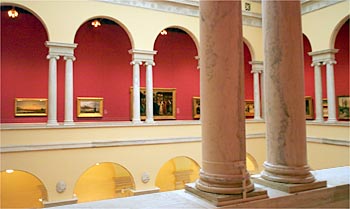
Directions and Parking
The Walters is located at 600 North Charles Street in Baltimore's historic Mt. Vernon Cultural District (http://www.mvcd.org/) , one mile north of the Inner Harbor. It is conveniently located near MTA bus lines (Nos. 3, 11, 31, 61, and 64) and the Centre Street Light Rail stop. The public entrance is located on Centre Street near the corner of Centre and Cathedral streets.
From Philadelphia, Wilmington, and Points North (I-95) I-95 south through the Ft. McHenry Tunnel to Exit 53 (I-395), to Martin Luther King, Jr. Blvd. Turn right onto Druid Hill Avenue, which becomes Centre Street. The Walters is on your left.
From Harrisburg, York, and Points Northwest (I-83) I-83 south to Maryland
Avenue exit. Turn left onto Maryland Avenue, which becomes Cathedral
Street. Turn left onto Centre Street. The Walters is on your left.
From Washington, D.C. and points South (I-95) I-95 north to exit 53,
to Martin Luther King, Jr. Blvd. Turn right onto Druid Hill Avenue,
which becomes Centre Street. The Walters is on your left.
All Right Parking lot is located at Centre and Cathedral streets. Tickets from this lot only may be stamped at the Walters for a discounted rate. Other nearby lots include the Peabody Garage at Centre and St. Paul streets and the Franklin Street Garage on West Franklin Street between Charles and Cathedral. The Clarion Hotel at the corner of Cathedral and Monument streets offers valet parking. Metered parking is also available.
copyright © 2001 The Walters Art Museum